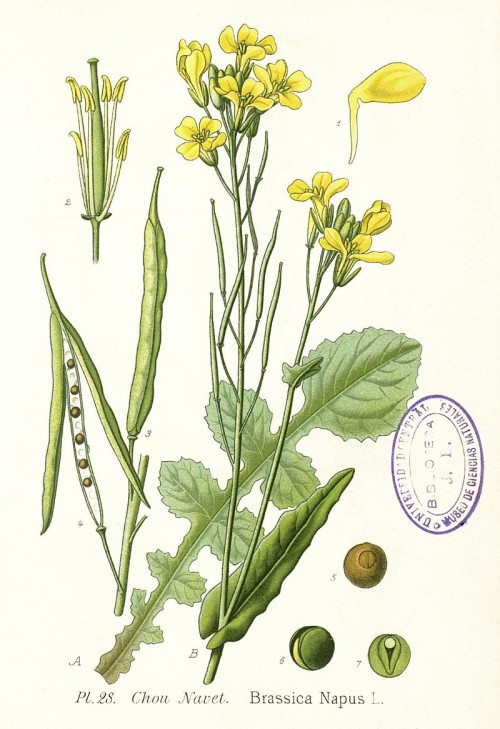Dies ist eine alte Version des Dokuments!
Brassica napus L. - syn.Rapa napus (L.) Mill.; Sinapis napus (L.) Brot.- Brassicaceae
Brassica napus subsp.napus - (oilseed) rape, canola, Raps
Brassica napus subsp.napus var. pabularia - rape kale, Hanover salad, Siberian kale, Schnittkohl
Brassica napus subsp.rapifera - Swedish turnip, Steckrübe
Annual or biennial herb, up to 1.50m tall, only known in cultivation; stems erect, branched above; basal and lowermost cauline leaves long petiolate, pinnately lobed or lyrate, sometimes undivided; cauline leaves sessile, lanceolate, ovate, or oblong, base amplexicaul; flowers bright yellow; fruit linear, up to 10cm long, sessile, divaricate or ascending; seeds dark brown or blackish, globose, 1.5-3mm in diam.
„Brassica napus is one of the most important sources of seed vegetable oil. The seed oil is also used in the manufacture of lubricants, grease, lacquers, varnishes, soap, resins, nylon, plastics, insect repellents, stabilizers, and pharmaceuticals. The green parts and fleshy roots are eaten as vegetables.“
http://www.efloras.org/florataxon.aspx?flora_id=2&taxon_id=200009263
„The glucosinolate content of three fodder kales, one fodder rape, one semi-artificial rape and one radicole were determined. The major glucosinolates (mmol kg−1 dry matter) were: in kale leaf, glucobrassicin (3.21) and sinigrin (3.12); in kale stem, sinigrin (5.82); in rape leaf, gluconapin (3.14) and progoitrin (13.99); in rape stem, gluconapin (3.29) and progoitrin (20.18); in semi-artificial rape leaf, gluconapin (25.64) and progoitrin (9.00); in semi-artificial rape stem, gluconapin (35.33) and progoitrin (12.08); in radicole leaf, progoitrin (4.74) and glucobrassicin (3.28); and in radicole stem, gluconapin (3.26) and progoitrin (5.53).“
[The glucosinolate content of the leaf and stem of fodder kale (Brassica oleracea L.), Rape (Brassica napus L.) and radicole (Raphanobrassica)., Bradshaw, J.E., Heaney, R.K., Fenwick, G.R., McNaughton, I.H., Journal of the Science of Food and Agriculture, Vol.34(6), 1984, 571-575]
„Volatile organic compounds emitted by growing intact oilseed rape plants have been detected using an entrainment apparatus enabling volatile headspace analysis by thermal desorption coupled to capillary gas chromatography-mass spectrometry. In total, 22 volatile compounds were identified as being emitted during the flowering period. The main constituents were α-farnesene (a sesquiterpene); β-myrcene (a monoterpene); linalool (a monoterpene alcohol) and the ‘green leaf’ volatile (E)-3-hexen-1-ol acetate. These compounds constituted between 50 and 87% (mean 68%) of the total volatiles emitted in all of the entrainments carried out with flowering oilseed rape plants. The remaining constituents consisted of a range of compounds including other terpenoids, the characteristic ‘green leaf’ volatile (E)-3-hexen-1-ol, short chain alcohols and ketones, organic sulphides and nitrogen-containing compounds. These were generally present as minor constituents but some plant entrainments revealed that higher relative amounts could be emitted. This was particularly apparent for dimethyl disulphide, 3-methyl-2-pentanone, 3-hydroxy-2-butanone =acetoin, sabinene, isomyrcenol and (E)-3-hexen-1-ol. The possible role of the 22 compounds in respiratory mucosa and conjunctiva irritation associated with airborne releases from oilseed rape is discussed.“
[The identification of potential aeroallergen/irritant (s) from oilseed rape (Brassica napus spp. oleifera): volatile organic compounds emitted during flowering progression., Butcher, R.D., Macfarlane‐Smith, W., Robertson, G.W., Griffiths, D.W., Clinical & Experimental Allergy, Vol.24(12), 1994, 1105-1114]
„Separate headspace samplings of Brassica napus flowers and leaves in situ showed that six volatiles were emitted from the flowers only, 12 compounds were common to both flowers and leaves, and 11 compounds were emitted from the leaves only. The average emission of floral volatiles was 45 ng per flower per hr. Floral rhythmic emission was shown for sabinene and limonene, both emitted from flowers and leaves. In contrast, no rhythm of emission was detected for the major compounds emitted from the flowers only, i.e. α-farnesene, linalool and 3-carene. A rhythmic nature of emission could not be discerned after transfer to constant environmental conditions.“
[Emission of volatiles from flowers and leaves of Brassica napus in situ., Jakobsen, H.B., Friis, P., Nielsen, J.K., Olsen, C.E., Phytochemistry, Vol.37(3), 1994, 695-699]
„The response of the Ceutorhynchus assimilis antenna to volatiles in air entrainment-derived extracts of oilseed rape, Brassica napus, was studied using coupled gas chromatography (GC)-electroantennography (EAG) and coupled GC-single cell recording (SCR). By means of these techniques and coupled gas chromatography-mass spectrometry (GC-MS), 25 active compounds were identified, including isoprenoids and compounds derived from fatty acids and amino acids. Some of the latter, the isothiocyanates and goitrin, and probably indole and benzyl cyanide, are catabolites of glucosinolates.“
[Antennal perception of oilseed rape, Brassica napus (Brassicaceae), volatiles by the cabbage seed weevil Ceutorhynchus assimilis (Coleoptera, Curculionidae)., Blight, M.M., Pickett, J.A., Wadhams, L.J., Woodcock, C.M., Journal of chemical ecology, Vol.21(11), 1995, 1649-1664]
„Volatiles from oilseed rape, Brassica napus, flowers were sampled by air entrainment and their relevance to the natural odor profile of the flowers was confirmed by conditioned proboscis extension (CPE) assays with honeybee, Apis mellifera L., foragers. Coupled gas chromatography (GC)-CPE analysis of the air entrainment samples was used to locate key compounds involved in the recognition of B. napus flowers, and the compounds were then identified using coupled gas chromatography-mass spectrometry and comparison with authentic samples. Six regions of the gas chromatograms elicited CPE responses from bees previously conditioned to the total extract, and from these areas 16 compounds were identified that elicited CPE activity from conditioned bees when tested with synthetic samples. Eight of the 16, α-pinene, phenylacetaldehyde, p-cymene, α-terpinene, linalool, 2-phenyl-ethanol, (E,E)-α-farnesene, and 3-carene, gave the highest responses.“
[Identification of floral volatiles involved in recognition of oilseed rape flowers, Brassica napus by honeybees, Apis mellifera., Blight, M.M., Le Métayer, M., Delègue, M.H.P., Pickett, J.A., Marion-Poll, F., Wadhams, L.J., Journal of chemical ecology, Vol.23(7), 1997, 1715-1727]
„The major constituents identified were the monoterpenes limonene, sabinene, β-myrcene, and cis-3-hexen-1-ol acetate, a ‘green leaf’ volatile. The minor constituents included monoterpenes, sesquiterpenes, short chain aldehydes and ketones, other ‘green leaf’ volatiles and organic sulphides including the respiratory irritant, dimethyl disulphide.“
[Identification of volatile organic compounds emitted in the field by oilseed rape (Brassica napus ssp. oleifera) over the growing season., Smith, M., Clinical & Experimental Allergy, Vol.28(3), 1998, 332-338]

Masclef,A., Atlas des plantes de France, vol.2, t.28 (1890)
http://plantgenera.org/species.php?id_species=156079
